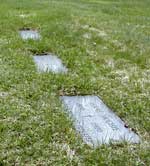|
|||||||||||||||
|
The Story
Resources
Background
|
By Chris Julin and Stephanie Hemphill
June 2001
ON A SUNNY, SPRING MORNING, A FEW MILES FROM DOWNTOWN DULUTH, Craig Grau climbs out of his van and goes walking among the graves at the Park Hill Cemetery. Only some of the graves have markers, because this section of the cemetery was reserved for poor people. But Grau has been here many times, and it only takes him a minute to find what he's looking for - three small granite slabs set low into the grass.
"They have the names, and they have the dates - the best they could tell on the birth dates. The death date they were sure of, which is 1920. And then the saying underneath each of them is, 'Deterred but not Defeated.'"

Grau doesn't know how the bodies of Elmer Jackson, Elias Clayton and Isaac McGhie ended up here.
"It's clear they did end up here. If you look at the records of the cemetery it has the three names, and it lists under cause of death, 'Lynched.'"
For 70 years, the bodies lay here in unmarked graves. The cemetery caretaker knew they were here, but no one asked. Craig Grau found out they were here 10 years ago. The cemetery is connected with the Lutheran church Grau belongs to, so he figured the church should mark the graves. He urged his church and the local NAACP to work together raising money for markers.

|
|
|
These three stones mark the graves of the lynching victims - Elmer Jackson, Isaac McGhie and Elias Clayton - at the Park Hill Cemetery in Duluth. (MPR Photo/Stephanie Hemphill) |
"He put in the first edition of his book that the final indignity was that people didn't even know where they were buried," says Grau. "And I think he's right. I think that was an indignity. So they are now marked. My thinking has been, they were not treated as human beings in the last days of their lives - they should be treated as human beings in their death."

